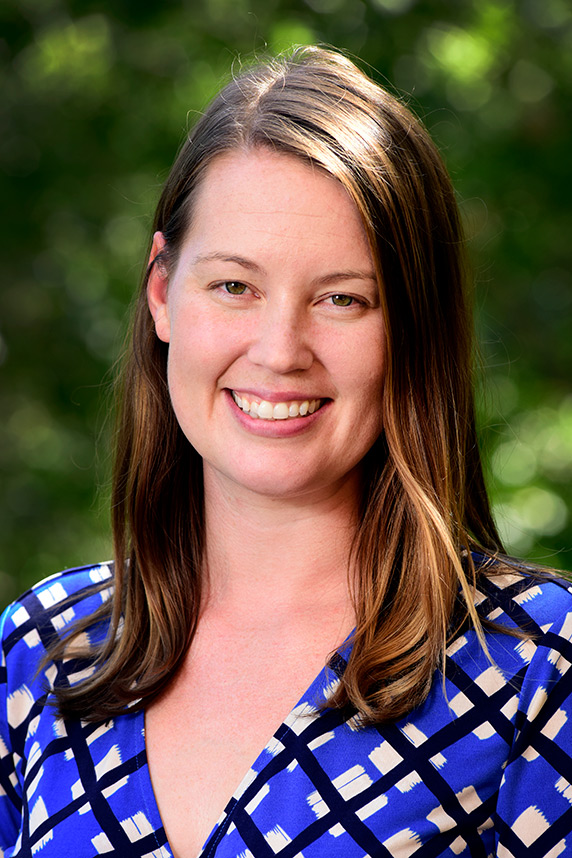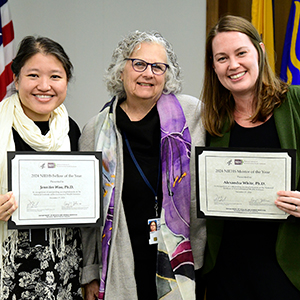 White said that as the field of mixture exposure analysis moves forward, there will be a greater need for innovative methods that can accommodate big data and incorporate a variety of different exposures. (Photo courtesy of Steve McCaw)
White said that as the field of mixture exposure analysis moves forward, there will be a greater need for innovative methods that can accommodate big data and incorporate a variety of different exposures. (Photo courtesy of Steve McCaw)A new method developed by NIEHS researchers and collaborators can help assess how exposures to chemical mixtures affect human health. The approach, published Apr. 7 in Environmental Health Perspectives, could provide better evidence for public health interventions that target multiple chemical exposures at the same time. Dietary recommendations, changes in consumer behavior, and regulations of industrial sources are examples of such interventions.
“Everything we are exposed to these days involves a combination of chemicals,” said Alexandra White, Ph.D., head of the Environmental and Cancer Epidemiology Group and senior author of the study. “This method asks about the risk associated with the mixture as a whole, rather than focusing on its individual components.”
A mixed bag
For decades, environmental health researchers have examined potential health effects by studying one chemical at a time. That approach makes for a straightforward experiment, but it does not mimic exposures people typically encounter in real life.
Statisticians have developed methods to analyze mixtures of chemicals found in the environment. Recent tools have been used to address health risks associated with exposures to ozone and particulate matter in air, phthalates and parabens in consumer products, and various heavy metals, among others.
However, these tools have their shortcomings, said lead study author Alexander Keil, Ph.D., an epidemiologist at the University of North Carolina at Chapel Hill, who also holds an appointment at NIEHS.
“Some of these statistical models assume that [the effects of] everything you throw into them will go in the same direction — that everything in a mixture is bad for you,” he said. That assumption might be true in some cases, such as heavy metals. However, the authors were interested in other cases, such as studies of certain nutrients or food additives, in which it is important to consider both beneficial and harmful effects.
 Keil said people he has never met before have reached out to learn more about the new method and discuss collaborating. “It is really resonating with people,” he said. (Photo courtesy of Alex Keil)
Keil said people he has never met before have reached out to learn more about the new method and discuss collaborating. “It is really resonating with people,” he said. (Photo courtesy of Alex Keil)White said that her own work on endocrine disruptors, a class of chemicals that can act like hormones in the body, showed that health effects are often unpredictable. She and Keil decided to devise a method to capture the effects from components of a mixture, whether they are beneficial, harmful, or even harmless.
Method for the masses
The researchers, along with NIEHS colleagues Katie O’Brien, Ph.D., Kelly Ferguson, Ph.D., and Shanshan Zhao, Ph.D., developed a method they called quantile g-computation. Keil said when he shared the method with other scientists, several commented on how complex it looked with its string of Greek letters and mathematical variables. However, he believes the method is simpler than the machine learning approaches used in epidemiology today. “It recaptures the beauty of classical statistical models that have been around for 50 to 100 years,” he said.
When the researchers tested the new method in a variety of simulations, they found it consistently outperformed another method for analyzing mixtures called weighted quantile sum regression. Since presenting the method at two conferences last year, they have been contacted repeatedly about potential collaborations.
 The new statistical method can assess the effect of chemical mixtures, such as compounds that find their way into drinking water from agricultural or industrial activities.
The new statistical method can assess the effect of chemical mixtures, such as compounds that find their way into drinking water from agricultural or industrial activities.White said she was struck by the enthusiasm of the scientific community, noting their manuscript pre-print was cited three times before the paper was officially published. “It is a method that can get at a very important research question, and it is something everyone can use,” she said. “It is a mixtures method for the masses.”
Protecting the public
Ultimately, the researchers believe their new method will help connect environmental health research to potential real-world actions.
“There's a real hunger in the scientific community to move away from abstract experimental designs and think about how we can improve public health,” said Keil. “I think this method is perfect for taking toxicologic or epidemiologic data and producing the kind of evidence we need to make informed decisions about the changes we can and should make in the world.”
Citation: Keil AP, Buckley JP, O’Brien KM, Ferguson KK, Zhao S, White AJ. 2020. A quantile-based g-computation approach to addressing the effects of exposure mixtures. Environ Health Perspect 128(4):47004.
(Marla Broadfoot, Ph.D., is a contract writer for the NIEHS Office of Communications and Public Liaison.)









